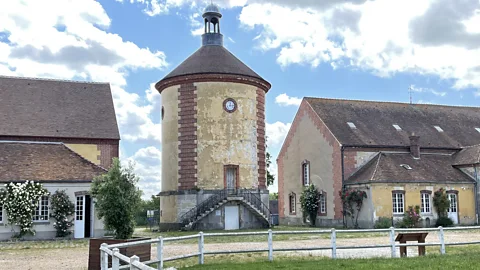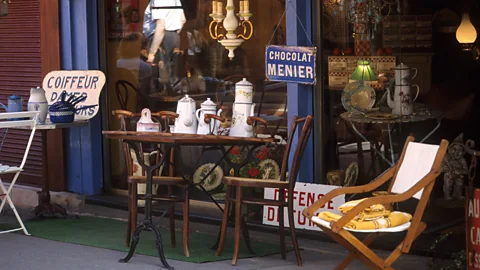Why Olympic visitors should stay in the Paris suburbs this summer
 Vladislav Zolotov/Getty Images
Vladislav Zolotov/Getty ImagesThe Ile de region and the Paris suburbs offer a refreshing alternative to the capital for those travelling to for the Olympics this July.
Imagine: you wake up in the morning in late July, the Sun's sneaking through the curtains, the birds are chirping and you hear the neigh of a horse. You look out of the window onto the courtyard below where a rider is returning to the stables after a canter in the fields.
You're staying in a riding school called the Haras de la Clairière, which rents out rooms on Airbnb from just €35 a night. You're one of 2.3 million people who have bought at least one ticket for an Olympic event. And, since the Olympic events are scattered across the Paris region, you've had the clever idea of booking a room in one of its rural extremities.
Le Haras de la Clairière is 60km west of Paris and, although it's a bit of a trek to the Eiffel Tower (40 minutes by train from the local station of Gazeran to the Gare Montparnasse, plus 15 minutes on the metro), it's handy for Olympic events taking place west of Paris like the cycling at the Vélodrome at Saint-Quentin-en-Yvelines, the equestrian events in the park of the Palace of Versailles or the mountain biking at Élancourt.
On the days when you don't have Olympic tickets, you can wander into the shade of the towering oaks of the Rambouillet forest, which is larger than Paris itself, row across the lake in front of the Rambouillet château or even visit an 18th-Century model farm.
And there are hundreds of places like this on the bucolic borders of the Paris region.
 John Laurenson
John LaurensonAirbnb, which is expecting 500,000 Olympic bookings, reports strong demand close to event sites in the suburbs.
Getting around Paris:
For example, they've seen a three-fold increases in listing views in Vaires-sur-Marne where the nautical stadium for the rowing and canoeing is situated, and in Le Bourget, where the climbing will take place. But don’t wait to book as people are catching on.
And even if you're heading to events in the city itself, staying in the suburbs can still be a good choice as it's cheaper, less touristy and allows you to explore beyond the usual landmarks.
Public transport is excellent in Ile-de- (as the Paris region is also called). It's a dense network with 390 train stations outside Paris itself. French public transport is heavily subsidised, so even though ticket prices have been raised during the Games, an "Origine-Destination" ticket to go anywhere in the Paris region will still only cost €6 (or €48 for 10). That means you can travel, say, the 70km south from Notre Dame to the town of Fontainebleau – where there's an extraordinary château in the middle of an even more enormous forest – for the price of a café crème.
Another option is Versailles, just 15 minutes by train to the centre of Paris. Here, as well as the palace, the gardens and Marie-Antoinette's toy village, you have an opera house inside the palace itself and, opposite it, the king's equestrian academy where 's man-of-horse theatre Bartabas puts on shows. And right opposite the palace is the Petit Bouillon Versailles. The revival of bouillons, cheap, traditional restaurants pioneered in the 19th Century, is the French restaurant phenomenon of the moment – and this is a worthy example.
 John Laurenson
John LaurensonOr you could head to St-Germain-en-Laye, 30km north-west of Paris: a fine old town with a fortified medieval castle and frequent trains that take you to the centre of Paris in 30 minutes. It also happens to be where the British Olympic team is staying. While you're there, don't miss the Maurice Denis Museum, a former hospital that the post-Impressionist painter bought and made into his home and studio, which contains some of his most beautiful paintings.
The east of Paris is where most of the Olympic action will be taking place, with the suburbs of Seine-Saint-Denis hosting the track and field events at the Stade de and the swimming at the Olympic Aquatic Centre and the Olympic Village.
If you prefer a rural stay, the cathedral town of Meaux (where Brie cheese is made) is surrounded by countryside and is just 46km from the Stade de (another one of those €6 half-hour trips by train). At the beginning of World War One, the German army got this far before French troops, many of whom were rushed to the frontline by Parisian taxi volunteers, stopped the advance at the Battle of the Marne. When not watching the 400m hurdles or the hammer throwing, visitors can explore the impressive Musee de la Grande Guerre with the largest collection of WWI uniforms in the world and a reconstruction of French and German trenches.
If you'd rather be closer to the action, Seine-Saint-Denis itself is another option. While it – like many other Parisian banlieues (suburbs) – doesn't have a great reputation, often associated with poverty and crime, has been investing hard in Seine-Saint-Denis in the run-up to the Olympics. The very-ecological Olympic Village is here, on an island in the Seine River linked to the metropolis by a new bridge. Also here is one of the first mega-stations of an ambitious new rail network called the Grand Paris Express that will open in time for the Games and speed connections with other parts of Ile-de-.
 StevenAllen/Getty Images
StevenAllen/Getty ImagesIn addition, there are many good, non-Olympic reasons to visit Seine-Saint-Denis. Its Saint-Ouen flea market is the world's biggest antiques market and a gold mine for vintage clothes, antiques and bric-a-brac. And don't miss the Chope des Puces, an unassuming café where local musicians play the "gypsy swing" tunes made popular by the Romani guitarist Django Reinhardt.
More like this:
• Paris 2024: What you need to know about the summer Olympics and Paralympics
Artistically and gastronomically, there's a lot going on in Seine-Saint-Denis, too. At Aubervilliers, near the Paris Aquatic Centre, Sidi Bou is the best fish couscous restaurant in the Paris region; while Muse, a Saint-Ouen restaurant in an abandoned factory-turned-squat-turned-indie movie production facility, is serving up African, Creole, Latin American and French flavours at bargain prices. Also in Saint-Ouen, French chef Thierry Marx is set to become the first name chef to open a bouillon this summer.
In Saint-Denis itself, Seine-Saint-Denis's main town, the Basilica of Saint-Denis is one of the world's oldest and most beautiful Gothic cathedrals and contains the remains of all the kings and queens of up to the Revolution.
A couple of hundred metres from the Basilica is the Marché Saint-Denis, the biggest and liveliest market in the Paris region with a splendid food hall of riveted iron built at the same time as the Eiffel Tower. This is where you should food shop if you're short-term letting in the area or just come and pick up a cheap and excellent Tunisian snack at a food stand called the Délices de Biskra. The owner, Djamila Hadji, tells me she loves the sights and sounds of this market where she's been working for decades. "It's a cinema!" she said.
Which you could say for the Paris region in general. There's so much to see, so much to discover. And now, more than ever, is the time.
--
